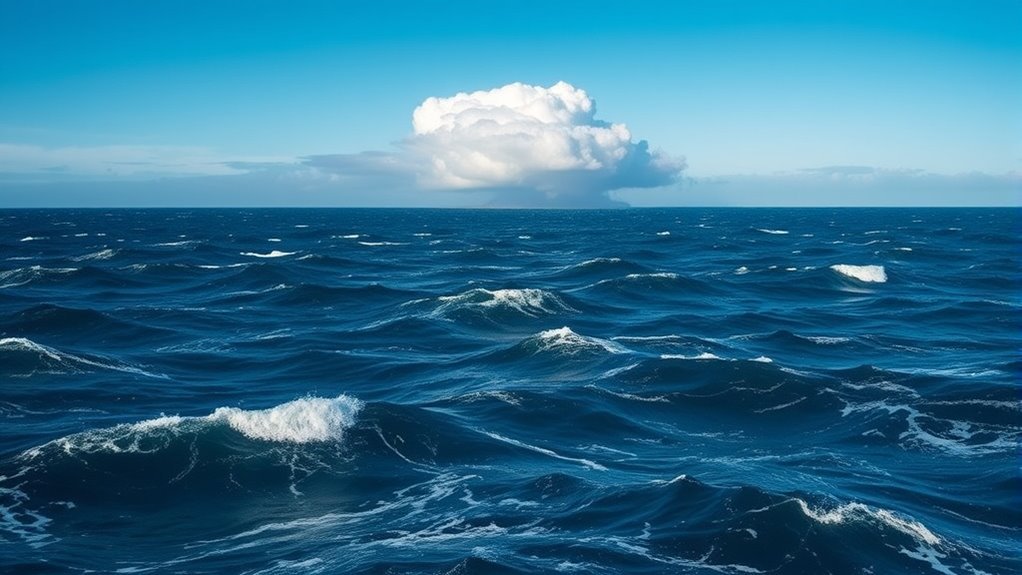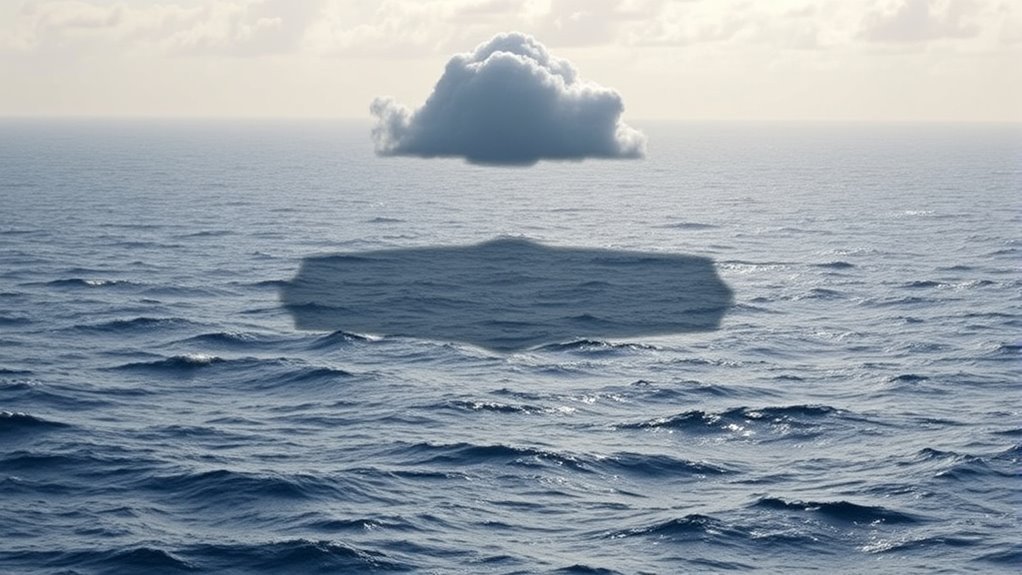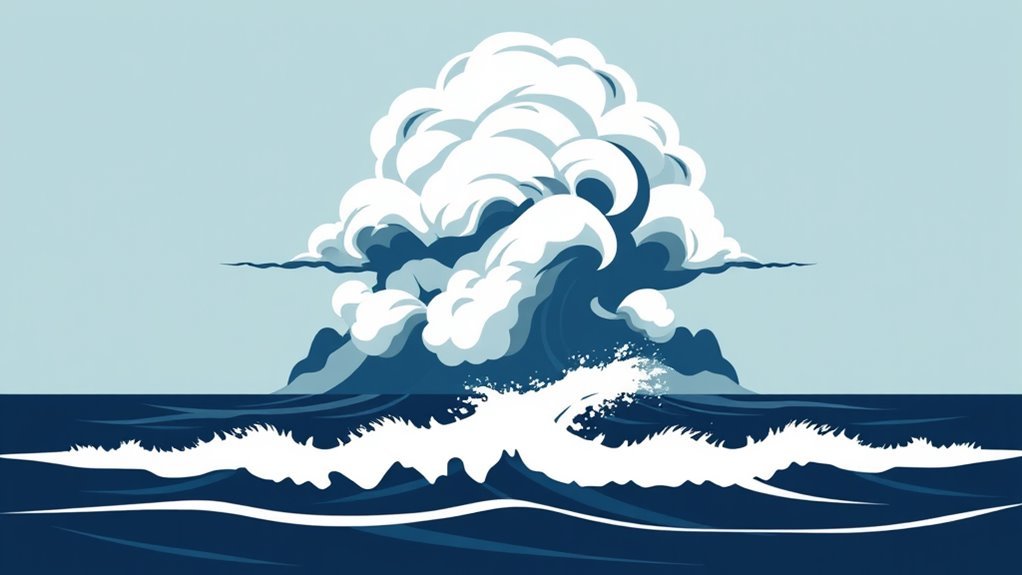Global wind circulation plays a vital role in shaping squall distribution and intensity. It directs heat and moisture across different regions, influencing where squalls develop. Trade winds and westerlies improve atmospheric instability, leading to more frequent squall occurrences. Local topography and sea surface temperatures further modify these patterns. Understanding these dynamics is fundamental, especially in the context of climate change effects on squall frequency and severity. More understanding into these interactions await further exploration.
Main Points
- Global wind circulation creates distinct wind belts that influence where squalls form and their frequency in different regions.
- The Coriolis effect causes winds to curve, affecting the trajectory and intensity of squalls as they develop.
- Seasonal changes in wind patterns modify moisture availability, impacting squall occurrence and intensity throughout the year.
- Warmer sea surface temperatures driven by ocean currents enhance atmospheric instability, promoting squall formation in certain areas.
- Topographical features interact with global wind patterns, leading to localized squall impacts in coastal and mountainous regions.
Understanding Global Wind Circulation
As the Earth rotates, it drives complex patterns of wind circulation that are essential for regulating climate and weather systems. These patterns are influenced by the uneven heating of the Earth's surface, where the equator receives more sunlight than the poles. This temperature disparity creates global wind belts, such as the trade winds, westerlies, and polar easterlies.
Additionally, the Coriolis effect, resulting from Earth's rotation, causes winds to curve rather than move in straight lines.
The interaction between land and sea further complicates these wind patterns, leading to variations in local climates. Areas near large bodies of water may experience milder winds and temperatures, while inland regions may face more extreme conditions.
Understanding these global wind circulation systems is vital, as they play a significant role in transporting heat, moisture, and energy across the planet, eventually shaping regional climates and weather phenomena.
The Formation of Squalls

Although squalls can occur in various weather conditions, they typically form when warm, moist air rises rapidly due to considerable atmospheric instability. This lifting often occurs in the presence of a cold front or during the daytime heating of the Earth's surface.
As the warm air ascends, it cools and condenses, leading to the formation of clouds and precipitation. The rapid upward movement of air generates strong downdrafts, which can create gusty winds and abrupt changes in weather conditions.
Additionally, squalls are often defined by their short duration and localized impact, which distinguishes them from larger storm systems. They can develop quickly, sometimes within minutes, catching observers off guard.
The combination of rising air, moisture, and temperature differentials creates an environment conducive to the formation of these intense weather phenomena, making squalls an important aspect of meteorological study in relation to global wind circulation patterns.
Key Factors Influencing Squall Distribution
Several key factors influence the distribution of squalls across different regions. Understanding these factors is essential for predicting squall activity and its impacts on local weather patterns.
- Sea Surface Temperature: Warmer ocean waters can improve atmospheric instability, leading to increased squall formation.
- Wind Patterns: Global wind circulation, including trade winds and jet streams, plays an important role in directing squalls towards specific areas.
- Topography: Mountain ranges and coastal features can influence local wind patterns, creating conditions conducive to squall development.
- Seasonal Changes: Seasonal variations, such as monsoon patterns, can alter moisture availability and atmospheric conditions, affecting squall frequency and intensity.
Regional Variations in Squall Activity

While squall activity can occur in various regions, remarkable differences exist in both frequency and intensity based on geographical and climatic factors.
Tropical regions, particularly those near the equator, often experience a higher incidence of squalls due to warm sea surface temperatures and abundant moisture. In contrast, temperate zones may see less frequent squalls, but those that do occur can be more intense, driven by interactions between cold and warm air masses.
Additionally, coastal areas are more susceptible to squalls, as local topography and sea breezes can improve squall development. Meanwhile, arid regions typically experience fewer squalls due to limited moisture availability.
Seasonal variations also play a vital role; for instance, squall activity may peak during specific months in certain regions, influenced by monsoonal patterns. Understanding these regional variations is essential for predicting squall occurrences and their potential impacts on local weather systems.
The Role of Ocean Currents in Squall Development
Ocean currents play an essential role in squall development by influencing local temperature variations.
These temperature changes can greatly affect the atmospheric conditions necessary for squall formation.
Additionally, the interaction between ocean currents and prevailing wind systems can improve or suppress squall activity in different regions.
Ocean Current Patterns
Understanding the complicated relationship between ocean current patterns and squall development reveals how these currents can greatly influence atmospheric conditions. Ocean currents act as conduits for heat and moisture, which are vital for squall formation. Their effects can be observed in several ways:
- Heat Distribution: Currents transport warm water, affecting local air temperatures and promoting instability.
- Moisture Supply: Currents can improve humidity levels in nearby regions, creating favorable conditions for squalls.
- Wind Patterns: The interaction between ocean currents and prevailing winds can lead to increased turbulence, important for squall initiation.
- Current Variability: Changes in current patterns, driven by climate factors, can alter the frequency and intensity of squalls in different regions.
These dynamics illustrate the complicated connections between oceanic and atmospheric processes.
Temperature Variations Influence
As temperature variations in ocean currents play a significant role in squall development, they influence atmospheric stability and moisture content.
Warm currents raise sea surface temperatures, leading to increased evaporation and higher humidity in the overlying air. This improved moisture supply can contribute to the formation of instability in the atmosphere, which is essential for squall formation.
Conversely, colder currents can suppress evaporation and result in drier air, reducing the likelihood of squalls.
The interplay between these temperature variations and ocean currents is critical in determining regional squall patterns. Understanding this relationship helps meteorologists predict squall occurrences and their intensity, highlighting the importance of oceanic influences on weather phenomena.
Interaction With Wind Systems
While the dynamics of wind systems are complex, their interaction with ocean currents greatly influences squall development. Ocean currents, which transport heat and moisture, play a vital role in modifying atmospheric conditions.
The convergence of warm, moist air from ocean currents with cooler air from prevailing winds can create instability, leading to squall formation. Key factors include:
- Temperature Gradients: Differences in water temperature can improve evaporation, fueling squalls.
- Current Direction: The orientation of ocean currents can redirect wind flow, impacting squall trajectories.
- Moisture Content: Currents rich in moisture can increase the likelihood of precipitation during squalls.
- Seasonal Variability: Changes in ocean current patterns seasonally can alter squall frequency and intensity.
These interactions underscore the complex relationship between oceanic and atmospheric processes.
Predicting Squalls: Tools and Techniques
Predicting squalls requires an understanding of various tools and techniques employed in meteorology.
Key elements include meteorological models that simulate atmospheric conditions, remote sensing technologies that gather real-time data, and advanced data analysis techniques that interpret these findings.
Together, these resources augment the accuracy of squall predictions and improve response strategies.
Meteorological Models Overview
Meteorological models play an essential role in forecasting squalls, which are sudden, intense storms often defined by strong winds and heavy rain. These models utilize complex algorithms to simulate atmospheric conditions, allowing meteorologists to predict squall occurrences and their severity.
Various techniques contribute to the accuracy of these forecasts:
- Numerical Weather Prediction (NWP) – Employs mathematical models of the atmosphere and oceans.
- Data Assimilation – Integrates real-time observational data into predictive models.
- Ensemble Forecasting – Generates multiple simulations to account for uncertainty in predictions.
- High-Resolution Modeling – Focuses on smaller geographical areas to improve detail in forecasts.
Through these methods, meteorological models greatly enhance the understanding and forecasting of squalls, contributing to better preparedness and response strategies.
Remote Sensing Technologies
Advanced remote sensing technologies play an essential role in the prediction of squalls, offering real-time data that boosts forecasting accuracy. These technologies include satellite imagery, radar systems, and ground-based observational networks, which collectively provide extensive coverage of atmospheric conditions.
Satellite systems, such as geostationary and polar-orbiting satellites, monitor cloud formation and moisture patterns, vital for identifying potential squall development. Doppler radar improves the detection of wind shear and precipitation intensity, allowing meteorologists to track storm movements.
Additionally, unmanned aerial vehicles (UAVs) contribute significant in-situ data from hard-to-reach areas. The integration of these remote sensing technologies augments situational awareness and supports timely warnings, enabling communities to prepare for the impacts of squalls more effectively.
Data Analysis Techniques
The integration of remote sensing technologies sets the foundation for effective data analysis techniques in predicting squalls. These techniques enable meteorologists to interpret extensive datasets and improve forecasting accuracy.
Key methodologies include:
- Statistical Analysis: Employing regression models to identify patterns and correlations between wind circulation and squall occurrences.
- Machine Learning: Utilizing algorithms to analyze historical data, increasing the predictive capabilities by recognizing complex patterns.
- Numerical Weather Prediction (NWP): Implementing sophisticated computational models to simulate atmospheric dynamics and project future weather conditions.
- Data Assimilation: Merging observational data with model outputs to refine predictions and improve real-time monitoring.
Together, these techniques provide a robust framework for understanding and predicting squall events, ultimately aiding in timely warnings and risk management.
Implications of Squall Patterns on Climate Change
As climate change intensifies, alterations in squall patterns have emerged as a notable area of concern for researchers. These changes are primarily driven by shifting global wind circulation, which can lead to more frequent and severe squalls in certain regions.
The consequences are complex, affecting both ecosystems and human activities. Increased squall intensity can result in improved precipitation and wind speeds, potentially leading to flooding, erosion, and damage to infrastructure.
Additionally, altered squall patterns may disrupt local weather systems, impacting agriculture and water resources. Coastal areas, particularly vulnerable to squalls, face heightened risks from storm surges and sea-level rise.
Understanding these dynamics is vital for developing flexible strategies to mitigate the impacts of climate change. As researchers continue to investigate the connections between squalls and climate change, their findings will be essential for informing policymakers and communities working to bolster resilience in the face of evolving weather patterns.
Common Questions
How Do Squalls Differ From Other Types of Storms?
Squalls are marked by sudden, intense wind shifts and rainfall, often occurring over short durations. Unlike other storms, they typically form quickly and dissipate rapidly, leading to brief yet severe weather conditions.
What Is the Historical Significance of Squalls in Maritime Navigation?
The historical significance of squalls in maritime navigation lies in their unpredictability, often causing sudden challenges for sailors. Navigators learned to respect these storms, adjusting their strategies to mitigate risks associated with rapid weather changes at sea.
Can Squalls Affect Air Travel Safety?
Squalls can considerably affect air travel safety. Their sudden onset and unpredictable intensity may lead to turbulence, reduced visibility, and challenging landing conditions, prompting pilots to exercise caution and potentially alter flight paths for passenger safety.
Are Squalls More Frequent During Certain Seasons?
Research indicates that squalls tend to be more frequent during specific seasons, particularly in warmer months when atmospheric conditions are conducive to their formation, leading to increased occurrences in tropical and subtropical regions.
How Do Human Activities Influence Squall Formation?
Human activities, such as urbanization and deforestation, alter local climates, potentially increasing squall formation. These changes can disrupt natural weather patterns, intensifying squall frequency and severity in affected regions, thereby impacting ecosystems and human communities.

